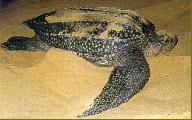|
Ponte Malongane falls within the famous Maputoland coastline which is the nesting ground to the famous Leatherback and Loggerhead Turtles. We are fortunate enough to have these wonderful creatures nest along the beach every summer from October and December, and evening trips can be arranged for small groups to enjoy this memorable experience.
Sea turtles fall into one of the most ancient reptilian orders whose fossil history reaches back 200,000,000 years. There are five species which have survived and still inhabit our Maputoland waters : The Leatherback; Loggerhead; Green; Olive Ridley and Hawksbill Turtles. These five species neither compete for food nor space and are an impressive example of the occupation of different niches which leads to a harmonious existence.
The turtles nest in summer at night when the female comes out of the surf and rests in the shallow water, lifting her head on the alert for danger. They are easily disturbed at this stage. Satisfied that there is no danger, she will make her way up the beach well above the high water mark where she will find a suitable site. She will then begin digging a body cavity with her fore-flippers throwing sand backwards until she can nestle down to a level where her carapace is level with the surrounding beach. She will then dig an egg cavity with her hind flippers some 45 cm deep and flask shaped. The 120 soft-shelled, white, eggs are then dripped in bursts of 1-4. Once she has finished laying, she will drop sand to cover the eggs, feeling gently with her hind flippers until the hole is filled level with the beach. She kneads and presses the surface until it is packed hard. After this she will disguise the nest by vigorously throwing sand with her fore-flippers and, in an exhausted state, she returns to the sea.
After 55 - 65 days the hatchlings (using an egg tooth on the end of their beaks) cut their way out of the egg and straighten out. After the bulk of the clutch has emerged, they start to scrabble at the walls and roof of the chamber bringing down sand which passes through the body of the hatchlings forming a new floor which gradually thickens, bringing the hatchlings to the surface of the beach rather like a lift. If the hatchlings reach the surface during the heat of the day, they are automatically inhibited from
|
|



